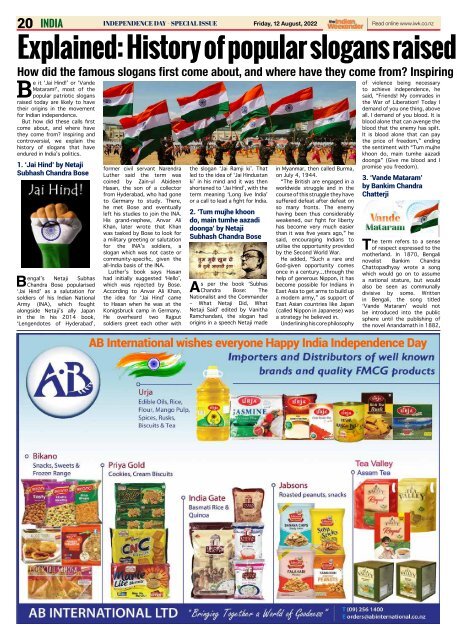The Indian Weekender
You also want an ePaper? Increase the reach of your titles
YUMPU automatically turns print PDFs into web optimized ePapers that Google loves.
20 INDIA<br />
INDEPENDENCE DAY - SPECIAL ISSUE<br />
Friday, 12 August, 2022<br />
Read online www.iwk.co.nz<br />
Explained: History of popular slogans raised<br />
How did the famous slogans first come about, and where have they come from? Inspiring a<br />
Be it ‘Jai Hind!’ or ‘Vande<br />
Mataram!’, most of the<br />
popular patriotic slogans<br />
raised today are likely to have<br />
their origins in the movement<br />
for <strong>Indian</strong> independence.<br />
But how did these calls first<br />
come about, and where have<br />
they come from? Inspiring and<br />
controversial, we explain the<br />
history of slogans that have<br />
endured in India’s politics.<br />
1. ‘Jai Hind’ by Netaji<br />
Subhash Chandra Bose<br />
Bengal’s Netaji Subhas<br />
Chandra Bose popularised<br />
‘Jai Hind’ as a salutation for<br />
soldiers of his <strong>Indian</strong> National<br />
Army (INA), which fought<br />
alongside Netaji’s ally Japan<br />
in the In his 2014 book,<br />
‘Lengendotes of Hyderabad’,<br />
former civil servant Narendra<br />
Luther said the term was<br />
coined by Zain-ul Abideen<br />
Hasan, the son of a collector<br />
from Hyderabad, who had gone<br />
to Germany to study. <strong>The</strong>re,<br />
he met Bose and eventually<br />
left his studies to join the INA.<br />
His grand-nephew, Anvar Ali<br />
Khan, later wrote that Khan<br />
was tasked by Bose to look for<br />
a military greeting or salutation<br />
for the INA’s soldiers, a<br />
slogan which was not caste or<br />
community-specific, given the<br />
all-India basis of the INA.<br />
Luther’s book says Hasan<br />
had initially suggested ‘Hello’,<br />
which was rejected by Bose.<br />
According to Anvar Ali Khan,<br />
the idea for ‘Jai Hind’ came<br />
to Hasan when he was at the<br />
Konigsbruck camp in Germany.<br />
He overheard two Rajput<br />
soldiers greet each other with<br />
the slogan ‘Jai Ramji ki’. That<br />
led to the idea of ‘Jai Hindustan<br />
ki’ in his mind and it was then<br />
shortened to ‘Jai Hind’, with the<br />
term meaning ‘Long live India’<br />
or a call to lead a fight for India.<br />
2. ‘Tum mujhe khoon<br />
do, main tumhe aazadi<br />
doonga’ by Netaji<br />
Subhash Chandra Bose<br />
As per the book ‘Subhas<br />
Chandra Bose: <strong>The</strong><br />
Nationalist and the Commander<br />
– What Netaji Did, What<br />
Netaji Said’ edited by Vanitha<br />
Ramchandani, the slogan had<br />
origins in a speech Netaji made<br />
in Myanmar, then called Burma,<br />
on July 4, 1944.<br />
“<strong>The</strong> British are engaged in a<br />
worldwide struggle and in the<br />
course of this struggle they have<br />
suffered defeat after defeat on<br />
so many fronts. <strong>The</strong> enemy<br />
having been thus considerably<br />
weakened, our fight for liberty<br />
has become very much easier<br />
than it was five years ago,” he<br />
said, encouraging <strong>Indian</strong>s to<br />
utilise the opportunity provided<br />
by the Second World War.<br />
He added, “Such a rare and<br />
God-given opportunity comes<br />
once in a century…through the<br />
help of generous Nippon, it has<br />
become possible for <strong>Indian</strong>s in<br />
East Asia to get arms to build up<br />
a modern army,” as support of<br />
East Asian countries like Japan<br />
(called Nippon in Japanese) was<br />
a strategy he believed in.<br />
Underlining his core philosophy<br />
of violence being necessary<br />
to achieve independence, he<br />
said, “Friends! My comrades in<br />
the War of Liberation! Today I<br />
demand of you one thing, above<br />
all. I demand of you blood. It is<br />
blood alone that can avenge the<br />
blood that the enemy has spilt.<br />
It is blood alone that can pay<br />
the price of freedom,” ending<br />
the sentiment with “Tum mujhe<br />
khoon do, main tumhe aazadi<br />
doonga” (Give me blood and I<br />
promise you freedom).<br />
3. ‘Vande Mataram’<br />
by Bankim Chandra<br />
Chatterji<br />
<strong>The</strong> term refers to a sense<br />
of respect expressed to the<br />
motherland. In 1870, Bengali<br />
novelist Bankim Chandra<br />
Chattopadhyay wrote a song<br />
which would go on to assume<br />
a national stature, but would<br />
also be seen as communally<br />
divisive by some. Written<br />
in Bengali, the song titled<br />
‘Vande Mataram’ would not<br />
be introduced into the public<br />
sphere until the publishing of<br />
the novel Anandamath in 1882,<br />
AB International wishes everyone Happy India Independence Day


















